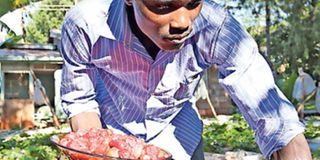Strawberries: From the farm to the cup

You are encouraged to harvest only red fruits. NMG PHOTO
Strawberry farming is picking up steadily in the country as farmers seek higher returns from the fruit of love.
However, many end up harvesting losses because of the mistakes they make while undertaking the venture.
Here, Seeds of Gold takes you through the agronomy of the crop.
Varieties
There are more than 40 varieties of strawberries, but three namely Chandler, Pajaro and Selva are very popular in the country. The three fall in the hybrid category and are mainly grown for export.
Fruits
If you want to get nice big, well coloured fruits from your back garden, the best place to plant them is in the brightest part. Strawberries grow better in a garden site that is open to direct sunlight most of the day. You should try to avoid very low-lying areas. Avoid planting where tomatoes, eggplant, potatoes, peppers have been grown in the last three years.
These plants can act as hosts for fungi and insect pests that build-up in the soil unless you place them on at least a three-year rotation schedule. It is possible to minimise the onset of disease and insect problems through rotation of the strawberry patch from one site to another, every time you carry out a new planting.
Propagation
Strawberries are normally propagated from split or runner plants, which are rooted. Splits or runners should be selected from vigorous, high-yielding and disease-free plants.
The crowns may be divided to get new plants but this is somewhat more difficult.
Make sure you get disease-free plants from a reputable nursery since it is not a good idea to utilise your own plants or neighbour’s.
Transplanting
Transplanting time will vary from region to region. Before planting the strawberries, soak the root for about an hour or two but not longer, and then plant them right away. It is best to plant on a cool cloudy day.
The plant should be placed with the crown at the soil surface or the roots may dry or the plant may rot.
The hole should be deep enough so that the roots can be placed straight down into the hole. Remove any damaged roots before planting.
Place the plant at the proper level into the hole and fill it with the soil. Put the soil down firmly and keep the plant well-watered for two weeks after planting.
Planting density
Spacing and row filling have effect on fruit yield: The common practice is 30cm between plants and 60cm between rows (90 cm for the vigorous cultivars).
Planting is done such that the mid-crown is at the soil line.
Deeper planting encourages root rots and leaves take longer to emerge. Transplanting can be done by hand or by a planter.
Raised bed
Planting on raised beds promotes good water drainage and larger berries are also encouraged to develop.
Beds should be 60 – 75cm wide, 100 – 120cm apart with plants 15–30cm apart over the beds. Runners are placed over the beds until wide rows are developed.
Containers
Growing strawberries in containers or pots is easy to do, even if you don’t have much outdoor space.
You can grow strawberries in containers on your balcony or any sunny outdoor area.
In fact, pots, cans and other containers are a great way to grow strawberries.
Just feed and water your container-growing strawberry plants regularly and enjoy strawberries throughout the year.
Irrigation
Irrigation is critical immediately after planting for crop survival.
As the plants are shallow rooted, they require 2.5cm of water per week for 12 weeks per growing season. Irrigation increases yields by 2.5 times.
Fertilisation
The strawberry plant is shallow-rooted and requires fertilisation during the growing season to keep it vigorous.
It is best to first get your soil tested for nutritional availability, pH and other important soil characteristics.
Avoid planting with fertilisers to avoid dehydration of the splits, since the plant goes into dormancy for 14 days.
Nitrogen
Nitrogen is important and is critical in growth. There can be response to nitrogen fertiliser on poor soils though an excess of the mineral will result in excessive vegetative growth with little or no fruit production.
After 30 days of planting, fix CAN 10g per hole in between the plants.
The second month, top dress with NPK 17:17:17, 10g (a tablespoon) per hole between the plants.
Fertilisers should be used to maintain soil fertility and maximise plant growth and fruit production.
Weed control
It is essential for good production. The weeds compete for water and nutrients with the shallow rooted strawberries.
They should be hand pulled but care must be taken not to damage the shallow roots of the strawberry plant. Some hand hoeing and weeding is necessary to keep weeds out of the inter-rows.
During weeding, train the runners away from inter-rows by placing in better positions.
Mulching
Mulching in strawberry farming will improve plant survival from strong cold/hot dry winds.
It reduces low temperature injury and conserve moisture/constant soil moisture.
Mulching leads to a rise in volunteer weeds
For straw mulches, slugs and rodents increase and there is extra heating if put on too thick during dry conditions. For organic mulch, spread 5-8cm thick. You can also use plastic mulches.
Harvesting
Fruit harvested in the morning will usually have a longer shelf-life.
Pick the berries when the top of the strawberry is completely red, once picked they will not continue to ripen.
Make sure you pick all ripe berries. A fruit left on the plant over ripens, which helps promote development of disease and causes insect problems.
Tips
Post-harvest handling.
The Strawberries have a short fresh period and, therefore, the cold chain is very critical during the post-harvest period of the berries.
Keep the picked berries out of sun, wind and dust. The useful post-harvest life of strawberry depends on the cultivar, degree of ripeness, handling and care, temperature when picked and kept.




